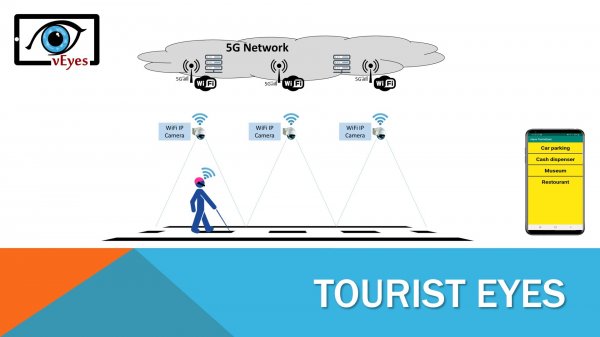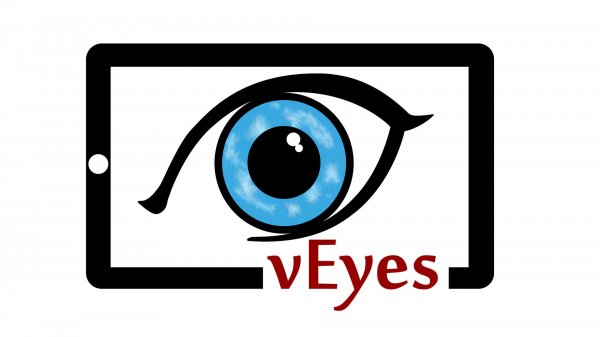Exhibitors 2019
- 3D PRINTING
- ART
- EDUCATION
- HOME AUTOMATION
- INTERNET OF THINGS
- KIDS & EDUCATION
- RECYCLING & UPCYCLING
- ROBOTICS
- SCIENCE
- YOUNG MAKERS (< 18)
- BIOLOGY
- GAMES
- ARTIFICIAL INTELLIGENCE
- OPEN SOURCE
- NEW MANUFACTURING
- FABRICATION
- WELLNESS & HEALTHCARE
- ENERGY & SUSTAINABILITY
- FOOD & AGRICULTURE
- 3D SCANNING
- CULTURAL HERITAGE
- AEROSPACE
- HACKS
- MUSIC & SOUND
- ARTISANS & NEW CRAFT
- FASHION & WEARABLES
- DRONES
- STEAM PUNK
- ARDUINO
- CROWDFUNDING
Tourist Eyes
Blind people encounter enormous difficulties in visiting unknown places, even if they have traditional supports like a white stick or a guide dog. A possible solution is to run a GPS‐based application on the smartphone of the blind person. However, this does not give a sufficiently high‐precision to guarantee safety for the blind person when he moves in the city and does not work indoor.
The idea is to install IP cameras in the place of interests area, where blind tourists moving in a city. They wear a hat with a specific color, in order to be localized and tracked by the system.
The idea is to install IP cameras in the place of interests area, where blind tourists moving in a city. They wear a hat with a specific color, in order to be localized and tracked by the system.
Italy
vEyes (virtual Eyes) - ONLUS
vEyes (virtual Eyes) is a non-profit organizzation, born in 2012, whose interest are on assistive technologies (with particular reference to visual impairment), diagnostic tools for medical and biomedical research, bioinformatics and genetics research (with a focus on rare degenerative diseases of sight). vEyes cover the specific technical development and programming skills thanks to the competence in R&D (Research and Development) activities and its certified know-how derived from the collaboration between professors, doctoral and post-doctoral students, Italian universities, clinical center. Moreover, vEyes, based on the existing own network, will reach a large number of patients affected by rare eye diseases in collaboration with the most important Italian associations of patients. All the projects and activities of vEyes are developed in vEyes Land, a campus extended on 48,000 square meter park on the Etna volcano. Inside, there are offices, labs, training rooms, apartments for researchers and collaborators, etc.
The most important projects and activities of vEyes are: vEyes Wear, redEyes, Leonard, visual BCI (Brain Computer Interfaces), Poseidon 2.0, Arianna and Tourist Eyes.
vEyes Wear is an open hardware and software platform based on glasses and belt, connected to an Android device (smartphone or tablet) where a blind can install “building blocks” (like a Lego) where every block is simply an assistive device for blind people.
redEyes is the most important component of the project vEyes RRE (Red Reflex Examination) and permits to test for the red reflex in a child, without drugs, using only an Android Smartphone, and search for early detection of vision threatening abnormalities such as cataracts, glaucoma, retinoblastoma, retinal abnormalities, etc.
Leonard is a system that converts the movements of conductor’s hands and arms in a click (like a metronome signal) and sends it to the bone conduction headphones of the musicians, if they are blind.
In visual BCI we’re studying the electrical activity of visual cortex, using our own Brain Computer Interfaces.
Poseidon 2.0 permits to trace a blind swimmer and to signal the end of the lane in pool, or if he/she is losing the route.
Arianna includes: a big database of clinical and genetic data, a set of interfaces for the integration between any external Web Registry and the vEyes RNP (National Patients registry) Web Registry, a neural network for Automatic Diagnosis of sight’s rare diseases.
The most important projects and activities of vEyes are: vEyes Wear, redEyes, Leonard, visual BCI (Brain Computer Interfaces), Poseidon 2.0, Arianna and Tourist Eyes.
vEyes Wear is an open hardware and software platform based on glasses and belt, connected to an Android device (smartphone or tablet) where a blind can install “building blocks” (like a Lego) where every block is simply an assistive device for blind people.
redEyes is the most important component of the project vEyes RRE (Red Reflex Examination) and permits to test for the red reflex in a child, without drugs, using only an Android Smartphone, and search for early detection of vision threatening abnormalities such as cataracts, glaucoma, retinoblastoma, retinal abnormalities, etc.
Leonard is a system that converts the movements of conductor’s hands and arms in a click (like a metronome signal) and sends it to the bone conduction headphones of the musicians, if they are blind.
In visual BCI we’re studying the electrical activity of visual cortex, using our own Brain Computer Interfaces.
Poseidon 2.0 permits to trace a blind swimmer and to signal the end of the lane in pool, or if he/she is losing the route.
Arianna includes: a big database of clinical and genetic data, a set of interfaces for the integration between any external Web Registry and the vEyes RNP (National Patients registry) Web Registry, a neural network for Automatic Diagnosis of sight’s rare diseases.
A14 (pav. 6)




















































































